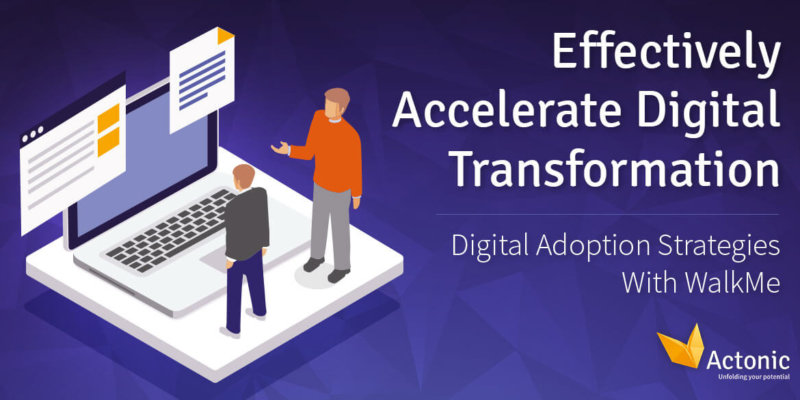WalkMe: Digital Transformation Strategy
Successful Digital Transformation with a WalkMe Strategy
Let us ask you a question: Why is it important to think and talk about digital transformation in businesses today? You might be able to guess the answer: COVID-19. The worldwide pandemic taught us why a digitalized workspace should be standard in every industry. Find out in this article what steps need to be taken for a digital transformation and how our WalkMe strategies assist you with that.
Distinction: Digitalization vs. Digital Transformation
Digitalization means digitalizing analog media (e.g. pictures, papers, movies) as well as digitalizing processes connected to them. For example: Instead of writing letters and notes, you use e-mails to communicate in your organization.
Digital Transformation is taking one step further into using technology in order to find solutions, to long for improvements and agility. Not only now tools are implemented, but also new processes. Therefore, digitalization is part of the digital transformation.
What does the Digital Transformation entail?
Digital transformation is causing changes in our society and economy. By breaking free from outdated processes and old school software, companies enable to be more agile. This means, for example, looking further into the future and longing for changes in data use, customer journey and expenditure of time across teams.
Depending on the area, in which the digital transformation will take place, different steps must be planned.
- Enabling remote workplaces – as well as new structures & processes
- Implementing new software
- Optimizing user experience with guides for software, website etc.
- Updating launching processes & self-service options
- Using data for analysis
- And many more
Challenges in Digital Transformation
In order to keep up with changes in modern technology, companies will face different challenges throughout their digital transformation:
- Working remote while staying connected: Enabling overall remote workplaces in a flexible, transparent environment
- The choice of software: Picking the right software for connected teams, great user experience and automated processes
- Userskills: Using employees skills differently, re- and upskilling them when needed
- Source of knowledge: Work with one database across teams to prevent information gaps and to avoid media breaks
- Satisfaction: Meeting different customer needs across all platforms
- Reporting: Making only data-based decisions
- Adaption to change: Fully adapting to changes in implemented software across users and customers
Here at Actonic we are aware of these challenges and reinforce organizations in introducing and adapting to these changes. How? By customizing digital WalkMe strategies for companies and all of their users.
Taking a step & overcoming digital thresholds
When organizations are forced into new structures or tools, users most likely won’t adapt, they might even resist the process. And companies at the same time can not afford to invest in software without the tool’s opportunities being unfolded. That is when WalkMe processes are stepping in and support businesses in their digital transformation journey.
Digital Transformation for Employees/Users
When the digital transformation for employees takes place, it is focusing on easing pain points, adaption and acknowledging new opportunities. Transforming workspaces oftentimes means implementing new software. Therefore, transformation strategies entail:
- On-demand, personalized training & onboarding
- Accelerated training with less time expenditure
- Guiding users through software
- Connecting workspaces & sources
- Using analytic dashboards to increase software usage
Digital Transformation for Customers
When steps for digital transformation take place, the focus lies on enhancing the user experience. This will happen through:
- Creating customer strategies & conception customer journeys
- Embedding self-service-chains & on-demand support guides
- Reducing support tickets & help desk costs
Digital Transformation for Products
Defining digitally transformed processes for products, releases and reporting:
- Improving launching processes for products
- Adding opportunities for self-service & self-support
- Introducing data dashboards & reports
- Guiding teams with tools
You will find more information on digital transformation here:
- WalkMe
Interested in other topics? Check out our blog:
- How to measure productivity of teams & quarters?
- Privacy Shield overturned: how can businesses ensure GDPR compliance?
- Are you truly Agile? Ask yourself these 6 simple questions

